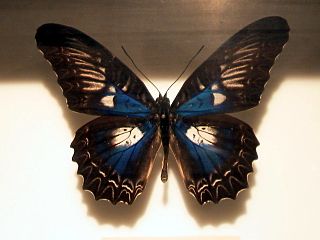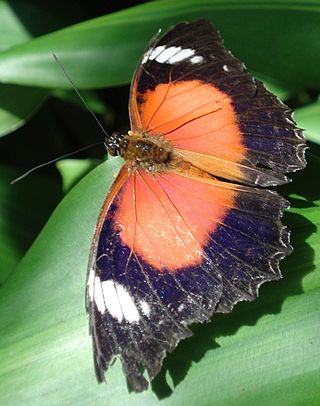
Penthesilea was an Amazonian queen in Greek mythology, the daughter of Ares and Otrera and the sister of Hippolyta, Antiope, and Melanippe. She assisted Troy in the Trojan War, during which she was killed by Achilles or Neoptolemus. The asteroid 271 Penthesilea, discovered in 1887, was named in her honor.

The Heliconiinae, commonly called heliconians or longwings, are a subfamily of the brush-footed butterflies. They can be divided into 45–50 genera and were sometimes treated as a separate family Heliconiidae within the Papilionoidea. The colouration is predominantly reddish and black, and though of varying wing shape, the forewings are always elongated tipwards, hence the common name.

Danaus genutia, the common tiger, is one of the common butterflies of India. It belongs to the "crows and tigers", that is, the Danainae group of the brush-footed butterflies family. The butterfly is also called striped tiger in India to differentiate it from the equally common plain tiger, Danaus chrysippus. The species was first described by Pieter Cramer in 1779.

Cethosia cyane, the leopard lacewing, is a species of heliconiine butterfly found from India to southern China, and Indochina. Its range has expanded in the last few decades, and its arrival in the southern part of the Malay Peninsula, including Singapore, is relatively recent.

The Australian Butterfly Sanctuary is a butterfly sanctuary and exhibit situated in the centre of Kuranda, Queensland, Australia.

Cethosia nietneri, the Tamil lacewing, is a species of nymphalid butterfly found in Sri Lanka and south India. The species name is after John Nietner who obtained specimens of the butterfly from Ceylon from which it was described.

Cethosia biblis, the lacewing biblis or red lacewing, is a species of heliconiine butterfly belonging to the family Nymphalidae.
Red lacewing can refer to either of two butterfly species in the genus Cethosia:

Cethosia, commonly called the lacewings, is a genus of butterflies of the subfamily Heliconiinae in the family Nymphalidae. They are found mainly in southeastern Asia as far south as Australia.

The Acraeini are a tribe of butterflies of the subfamily Heliconiinae in the family Nymphalidae.

The Niagara Parks Butterfly Conservatory is a butterfly house operated by the Niagara Parks Commission in Niagara Falls, Ontario, Canada. It is located approximately 9 kilometres (5.6 mi) north of Niagara Falls on the grounds of the Niagara Parks School of Horticulture, which is 40 hectares in size.

Cethosia myrina, the violet lacewing or brown accented butterfly, is a butterfly of the family Nymphalidae. It is found on the Indonesian islands of Sulawesi and Butung.

Cethosia hypsea, the Malay lacewing, is a butterfly of the family Nymphalidae. It is found in from Myanmar to Indonesia and the Philippines.

Cethosia cydippe, the eastern red lacewing, is a species of butterfly from Australia, New Guinea and nearby islands. The Australian subspecies, C. c. chrysippe, is known as the red lacewing butterfly.

Cethosia hypsea hypsina, the Malay lacewing, is a subspecies of Cethosia hypsea, a butterfly of the genus Cethosia belonging to the family Nymphalidae.

Cethosia luzonica , the Luzon lacewing, is a species of heliconiine butterfly endemic to the Philippines.

Adenia hondala, commonly known as hondala is a large, tuberous, woody climber which scrambles over other plants. It is found in the Indian subcontinent, including Sri Lanka, and in southeastern Asia. The tuber and the fruit are used as herbal remedies and the plant is used as a cure for snake bites. The caterpillars of several species of butterfly feed on this plant; these include the tawny coster, the clipper, the common cruiser and the Tamil lacewing.















